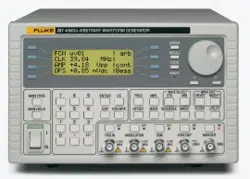Loading ...
Loading ...
Loading ...

291, 292, 294
Users Manual
Introduction
Two or more channels in one multi-channel generator can be synchronized together and
precise phase differences can be set between the channels. Two separate generators can
also be synchronized, giving a maximum of 8 channels that can be operated
synchronously.
Inter-Channel Synchronization
This section covers the use of a multi-channel instrument to produce two or more
synchronous signals, and certain restrictions which apply to some specific waveform and
frequency combinations.
Synchronizing Principles
Frequency synchronizing is achieved by using the clock output from a master channel to
drive the clock inputs of one or more slave channels. Any one channel can be the master
and any or all the others can be slaves; master, slaves and independent channels can be
mixed on the same instrument.
When frequency synchronization is switched on, an internal synchronizing signal from
the CPU synchronizes the channels at the specified inter-channel phase and re-
synchronizes them automatically every time the frequency is changed. The clock and
internal synchronization signals are shown in the inter-channel block diagram in the
appendix. Channels to be synchronized together must all be operated in continuous
mode.
For DDS-generated waveforms (see Principles of Operation in chapter 4) it is the
100 MHz signal that is distributed from master to slaves and channels can, in principle,
be frequency-synchronized with any frequency combination. However, the number of
cycles between the phase-referenced points will be excessively large unless the ratio is a
small rational number; for example a 2 kHz signal could be synchronized usefully with
10 kHz, 50 kHz, 100 kHz, etc., but not with 2.001 kHz.
For clock synthesized waveforms it is the PLL clock of the master which is distributed
from master to slaves; the clock frequency for master and slaves is therefore always the
same. The number of points comprising the waveforms should also be the same to ensure
that the waveforms themselves appear locked.
From the foregoing it is clear that only DDS slaves can be synchronized to a DDS master
and only clock synthesized slaves can be synchronized to a clock synthesized master. In
practice the constraints described are not severe as the most common use of
synchronization is to provide outputs of the same waveform at the same frequency, or a
harmonic of it, often with controlled phase offsets.
Master-Slave Allocation
Press the front panel INTER CHannel key to call up the inter-channel set-up screen.
mode: indep
phase: +000.0º
(actual: +000.0º
status: off view
13-2
1.888.610.7664 sales@GlobalTestSupply.com
Fluke-Direct.com
Loading ...
Loading ...
Loading ...
